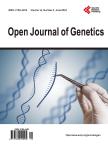Characterization of randomly amplified polymorphic DNA (RAPD) fragments revealing clonal variability in cercariae of avian schistosome <i>Trichobilharzia szidati</i>(Trematoda: Schistosomatidae)
Characterization of randomly amplified polymorphic DNA (RAPD) fragments revealing clonal variability in cercariae of avian schistosome <i>Trichobilharzia szidati</i>(Trematoda: Schistosomatidae)作者机构:Institute of Gene Biology Russian Academy of Sciences Moscow Russia
出 版 物:《Open Journal of Genetics》 (遗传学期刊(英文))
年 卷 期:2013年第3卷第3期
页 面:141-158页
学科分类:1002[医学-临床医学] 100214[医学-肿瘤学] 10[医学]
主 题:RAPD Variability Cercariae Heterogeneity Trichobilharzia szidati Repetitive DNA
摘 要:Recently we applied randomly amplified polymorphic DNA (RAPD) fingerprinting to detect clonal variability among individual cercariae within daughter sporocysts and rediae of 10 digenean trematodes (Platyhelminthes: Trematoda). The most variable RAPD patterns were obtained for Schistosomatidae representative-avian schistosome Trichobilharzia szidati. In this work, 50 polymorphic DNA fragments of approximately 300-1500 bp from RAPD patterns of individual T. szidati cercariae were cloned and sequenced. As a result genomic DNA sequences (total length of approximately 41,000 bp) revealing clonal variability in T. szidati cercariae were obtained and analyzed. The analysis indicated that these sequences contained tandem, inverted and dispersed repeats as well as regions homological to retroelements of two human parasites, Schistosoma mansoni and S. japonicum. Tandem and inverted repeats constituted 8.9% and 22.1% respectively, while the percentage of dispersed repeats was 21.0%. The average content of these components was 41.7% with the average AT content being 59.0%. About 40% of sequences included regions ranging in length from 96 to 1005 bp which displayed amino acid homology with open reading frame pol products of S. mansoni and S. japonicum retroelements: non-long terminal repeat retrotransposons (nLTRs, 76%), long terminal repeat retrotransposons (LTRs, 14%), and Penelope-like elements (PLEs, 10%). Most of these regions (86.4%) contained frameshifts, gaps, and stop-codons. The largest portion of them was homological to nLTRs of the RTE clade (67%). The number of sequences homologous to the members of CR1 lineage was 7 times smaller (9%). Homology with LTRs of Gypsy/Ty3 and BEL clades was revealed in 5% and 9% of cases respectively. We assume that the repetitive elements including retroelement-like sequences described in the current study may serve as the source of clonal variability detected previously in T. szidati and other digenean trematodes. Such genome regions



